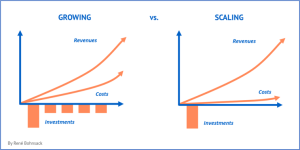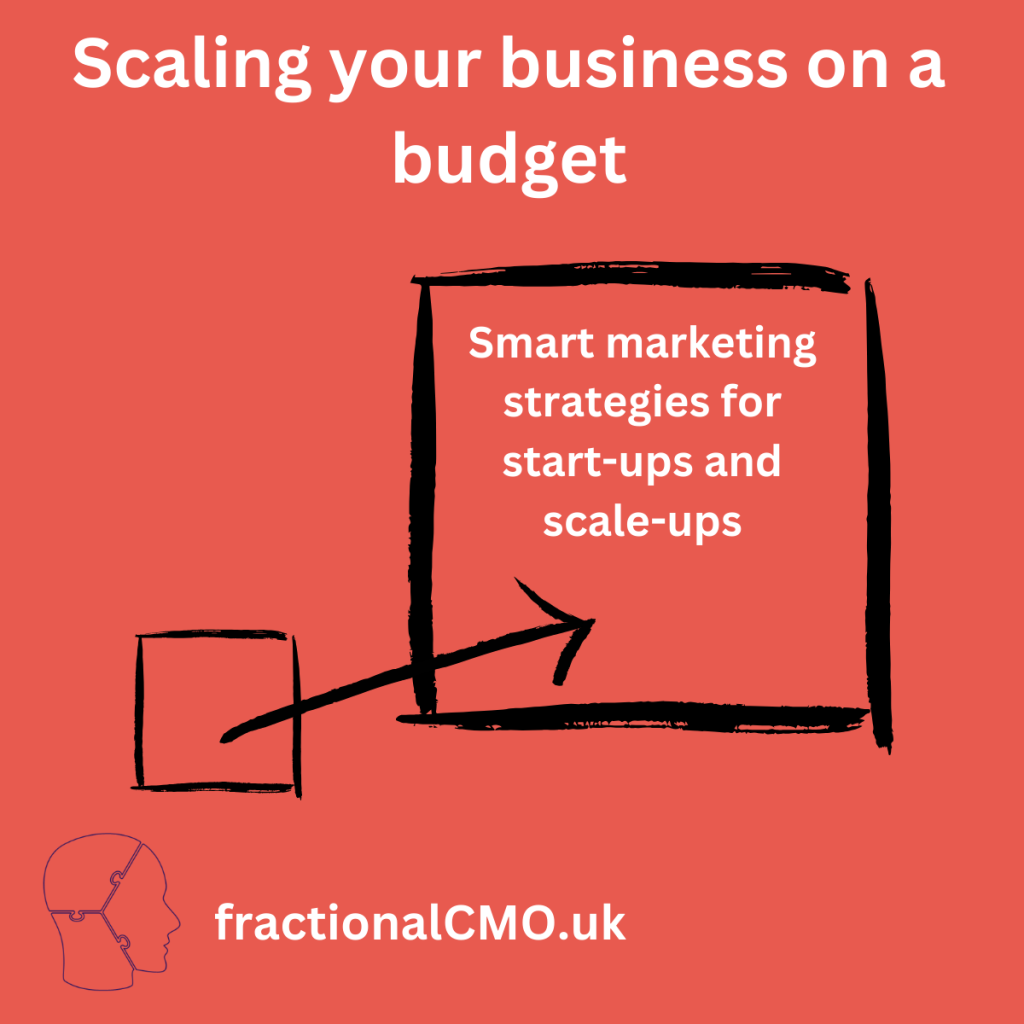Smart Marketing Strategies for Start-Ups and Scale-Ups
We live in uncertain times – economically, socially and politically. But you’re won’t get through the current situation by cutting costs and hunkering down. Growth is the best way forward – but growth can be expensive. Here are my tips on scaling your business on a budget.
Why scaling on a budget is essential for start-up businesses.
Most start-ups I’ve worked with are already pretty lean. Saving costs is built into the DNA of most successful founders.
That means when times are tough – even through no fault of your own – there are few areas to really cut costs.
You’re much better to try and grow the business. But of course, you want to do that on a budget. When you invest in growth, you want to ensure you see a return and build for the long term future success of your business.
Scaling is the key term here – it involves taking your current growth success and magnifying it. And that should be done without magnifying costs.
The image below (from René Bohnsack) shows the classic difference between business growth and scaling:

So growth – and particularly early growth – often involves constant investment (in people, in technology, in operations, in marketing). Scaling, on the other hand, is the art of growing revenue without the commensurate growth in investment.
Scaling a business is a big subject – in this article, I will be discussing the role of marketing in scaling.
1) You can't scale if the fundamentals aren't right
The ‘S’ in my SOPE Framework is strategy – and it’s where we start in the scaling process.
To be able to scale your business on a budget, you need to understand what works and what doesn’t work at a strategic level. Getting the foundations right are crucial to the success of any build project – and it’s the same for your business.
Know your customer
I’ve written about this before – understanding who your target customer really is, knowing their pain, needs and passions, are central to your success. I was on a call recently with a couple of business founders who, when it came down to it, had different views on who their target customer was. You can’t scale like that.
Sure, you can grow. You can build for and serve both markets. But you’re in real danger of increasing costs as you go. That’s growth, but it’s not how to scale the business.
It’s also important here to consider your TAM – Total Addressable Market – are there enough of your target customers that you can address (and realistically win) to allow you to scale?
If not, you may need to rethink your approach.
Get your value proposition right
Value propositions can change over time. And if it was pretty shonky in the first place, you may be going to market with entirely the wrong value proposition. That’s going to be an expensive mistake.
Test your value proposition against your target audience. If you tested it already last year, test it again.
Choose your channels
When looking at your channel plan, it pays to understand how scalable each channel can be.
For example, trade shows might generate lots of business for you, but are they scalable? How many valuable trade shows exist in your sector?
Can you scale PPC without increasing your costs at the same rate as you’re acquiring customers?
I’m not saying don’t do PPC or don’t go to trade shows – but ensure they are part of a balanced channel plan.
Double-down on channels that are productive, scalable and low cost.
And don’t believe everything you read on LinkedIn from the next self-appointed guru.
– Email still works (if you do it right, target your content and keep it relevant)
– SEO still works (even though the landscape is changing – good content still gets rewarded)
– Organic social still works (though even better when paired sensibly with paid social)
2) Team and tech
The ‘O’ in the SOPE Framework stands for ‘organisation’. You need to get the organisation right before you can scale.
Get the right people doing the right jobs
You need the right people to execute on your marketing plan and to be able to scale your business on a budget.
If content is at the centre of your strategy, you need people who live and breathe content. You can grow the business with a part-time copywriter and ChatGPT. But you won’t scale the business that way.
If paid media is top of your agenda, you need people (in house or external) who are serious experts in managing it.
Many marketers in start-ups are generalists – and that’s great (I’m one myself). But if you’re to invest in channels, you need specialist help.
It’s also crucial that marketing is embedded deeply in the organisation – collaborating with sales, finance and product. Scaling silos doesn’t work.
Think about new ways of working
Note that you may not need specialist help 5 days a week – that’s when fractional people, freelancers and agencies can come into play.
It’s old-school to think you need a full-time senior person in every seat of the C-Suite. It’s also very expensive.
The fractional market is changing business for the better – start-ups and scale-ups are gaining competitive advantage by engaging senior expertise they previously couldn’t afford.
Get your tech in place
I’ve said this before and I’ll say it again:
If your customers are your greatest asset (and they are), your CRM is your most important platform.
You simply can’t scale if the customer data is a mess.
The other tech you’ll require will depend on your channel strategy and approach – but think of getting your platforms right as part of your investment into scaling.
3) Build repeatable processes
Getting to grips with your processes is central to the successful scaling of your business on a budget.
Without processes in place, you’ll never cut the time it takes to complete tasks, measure success and deliver repeatability.
In ‘start-up growth’ phase, little attention is often paid to marketing operations – but as you scale, you need to think much more operationally. It’s not a mindset for every marketer, for sure.
Measure and record
You need to think again about how you measure success.
I worked recently with a business that worked really hard to measure success, but only at the top of the funnel. It’s quick and relatively easy to measure close to the top of the funnel – from social likes to website visits to leads generated…
But when a sales process takes time – usually the case in B2B but also in considered-purchase B2C cycles – the funnel gets fragmented, disassociated and confused. And measurement gets harder.
However, to achieve success, you need to measure all the stages of the funnel so you can decide which sections to improve and how.
The challenge with the business measuring top of funnel? They were great at delivering leads – often at ever-decreasing CPL – but found it really challenging to actually close sales.
Refocusing them on measuring full funnel actually increased the cost per lead but increased sales and dramatically improved overall acquisition costs.
Use HI alongside AI
Work out how AI can be woven into your marketing processes to save time and effort. This frees up time for HI (human intelligence) to focus on the profitable stuff.
Learn how to prompt successfully to save you time – but be aware of AI’s limitations.
AI is not there to replace the marketing department, but to enhance it.
4) Execute flawlessly!
True story: my first ‘head of marketing’ role saw me working with an external consultant (thankfully – almost unbeknownst to him, he became like a much needed mentor to me). We were launching a new product into a relatively crowded marketplace. He said to me,
“Richard, there’s only two things you need to do: First, plan meticulously and second, execute flawlessly!”
That was some challenge (and we made a pretty good go at it as it happens).
The key to execution is to constantly check that your activity is on point, but more importantly, on plan. Does your content directly address your customer profile and their pain points? Is your PR message on brand? Are you articulating and supporting your value proposition?
As an old CEO of mine used to say, “plan the work and work the plan”. If you build a robust plan, stick to it. That doesn’t mean slavishly stick to it without reviewing, but it does mean not heading off on tangents (chasing new markets, experimenting with new channels) if it’s not part of your wider plan.
Focus, focus, focus.
When scaling on a budget, you need to focus relentlessly and work hard.
Details make a difference. If tweaking a landing page for every Ad Group in your PPC campaign can lift conversion rate from 16% to 18%, it’s worth doing. 2% points in that context is a 12.5% increase in conversion rate. Your competitors probably won’t go as far and they won’t grow as quickly.
Responding to customer reviews – good or bad – with a personal message makes you stand-out as being customer-focused (don’t use AI for this!).
For SaaS companies, focus hard on activation, engagement and retention.
Scale your customer referral programme (in my experience, referred customers are more loyal and more likely to refer others).
Above all, plan the work and work the plan.
Other resources you may find useful:

